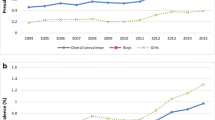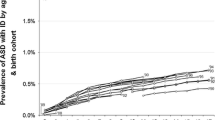Abstract
We analyzed data from the Israeli National Insurance Institute (NII). Autism Spectrum Disorder (ASD) incidence was calculated for all children born in Israel 1992–2009, and by population groups. Overall, 9,109 ASD cases among 2,431,649 children were identified. ASD cumulative incidence by age 8 years increased 10-fold during 2000–2011, from 0.49 % to 0.49 %, while other child disabilities in NII increased only 1.65-fold. There was a consistent increase in ASD incidence with advancing birth cohorts born 1992–2004, stabilizing among those born 2005–2009. ASD rates among Israeli Arabs were substantially lower, and increased about 10 years later than the general population. The findings suggest a role for ASD awareness, accessing of the government benefit, or the way the concept of ASD is perceived.




Similar content being viewed by others
References
Baird, G., Simonoff, E., Pickles, A., Chandler, S., Loucas, T., Meldrum, D., et al. (2006). Prevalence of disorders of the autism spectrum in a population cohort of children in South Thames: The Special Needs and Autism Project (SNAP). Lancet, 368(9531), 210–215. doi:10.1016/S0140-6736(06)69041-7.
Croen, L. A, Grether, J. K., Hoogstrate, J., & Selvin, S. (2002). The changing prevalence of autism in California. Journal of Autism and Developmental Disorders, 32(3), 207–15. Retrieved from http://www.ncbi.nlm.nih.gov/pubmed/12757365
Davidovitch, M., Hemo, B., Manning-Courtney, P., & Fombonne, E. (2013). Prevalence and incidence of autism spectrum disorder in an Israeli population. Journal of Autism and Developmental Disorders, 43(4), 785–793. doi:10.1007/s10803-012-1611-z.
Developmental Disabilities Monitoring Network Surveillance Year 2010 Principal Investigators., & Centers for Disease Control and Prevention. (2014). Prevalence of autism spectrum disorder among children aged 8 years—Autism and developmental disabilities monitoring network, 11 sites, United States, 2010. Morbidity and Mortality Weekly Report. Surveillance Summaries (Washington, D.C.: 2002), 63 Suppl 2(2), 1–21. Retrieved from http://www.ncbi.nlm.nih.gov/pubmed/24670961
Fombonne, E. (2001). Is there an epidemic of autism? Pediatrics, 107(2), 411–412. Retrieved from http://pediatrics.aappublications.org/content/107/2/411.short
Fombonne, E. (2003). The prevalence of autism. JAMA, 289(1), 87–89. Retrieved from http://www.ncbi.nlm.nih.gov/pubmed/22836322
Fombonne, E. (2009). Commentary: on King and Bearman. International Journal of Epidemiol, 38(5), 1241–2; author reply 1243–4. doi:10.1093/ije/dyp259
French, L. R., Bertone, A., Hyde, K. L., & Fombonne, E. (2013). Epidemiology of autism spectrum disorders. In The neuroscience of autism spectrum disorders (pp. 3–24). Elsevier. doi:10.1016/B978-0-12-391924-3.00001-6
Gal, G., Abiri, L., Reichenberg, A., Gabis, L., & Gross, R. (2012). Time trends in reported autism spectrum disorders in Israel, 1986–2005. Journal of Autism and Developmental Disorders, 42(3), 428–431. doi:10.1007/s10803-011-1252-7.
Gal, G., & Gross, R. (2010). Time trends in autism. The Israel Medical Association Journal, 12(11), 711–712. Retrieved from http://www.ncbi.nlm.nih.gov/pubmed/23959427
Gillberg, C., Cederlund, M., Lamberg, K., & Zeijlon, L. (2006). Brief report: “The autism epidemic”. The registered prevalence of autism in a Swedish urban area. Journal of Autism and Developmental Disorders, 36(3), 429–435. doi:10.1007/s10803-006-0081-6.
Gurney, J. G., Fritz, M. S., Ness, K. K., Sievers, P., Newschaffer, C. J., & Shapiro, E. G. (2003). Analysis of prevalence trends of autism spectrum disorder in Minnesota. Archives of Pediatrics and Adolescent Medicine, 157(7), 622–627. doi:10.1001/archpedi.157.7.622.
Hertz-Picciotto, I. (2009). Commentary: Diagnostic change and the increased prevalence of autism. International Journal of Epidemiology, 38(5), 1239–1241; author reply 1243–4. doi:10.1093/ije/dyp258
Hertz-Picciotto, I., & Delwiche, L. (2009). The rise in autism and the role of age at diagnosis. Epidemiology, 20(1), 84–90. doi:10.1097/EDE.0b013e3181902d15.
Hoffman, K., Kalkbrenner, A. E., Vieira, V. M., & Daniels, J. L. (2012). The spatial distribution of known predictors of autism spectrum disorders impacts geographic variability in prevalence in central North Carolina. Environ Health, 11(1), 80. doi:10.1186/1476-069X-11-80.
Honda, H., Shimizu, Y., & Rutter, M. (2005). No effect of MMR withdrawal on the incidence of autism: A total population study. Journal of Child Psychology and Psychiatry and Allied Disciplines, 46(6), 572–579. doi:10.1111/j.1469-7610.2005.01425.x.
Principal Investigators, Autism and Developmental Disabilities Monitoring Network Surveillance Year 2008, & Centers for Disease Control and Prevention. (2012). Prevalence of autism spectrum disorders—Autism and Developmental Disabilities Monitoring Network, 14 sites, United States, 2008. Centers for Disease Control and Prevention. Morbidity and Mortality Weekly Report. Surveillance Summaries (Washington, D.C.: 2002), 61(3), 1–19. Retrieved from http://www.ncbi.nlm.nih.gov/pubmed/22456193
Isaksen, J., Diseth, T. H., Schjølberg, S., & Skjeldal, O. H. (2012). Observed prevalence of autism spectrum disorders in two Norwegian counties. European Journal of Paediatric Neurology, 16(6), 592–598. doi:10.1016/j.ejpn.2012.01.014.
Isaksen, J., Diseth, T. H., Schjølberg, S., & Skjeldal, O. H. (2013). Autism spectrum disorders—Are they really epidemic? European Journal of Paediatric Neurology, 17(4), 327–333. doi:10.1016/j.ejpn.2013.03.003.
Israeli, A. (2007). Diagnosis of children suffering from autism PDD (the autism spectrum). Ministry of Health, Israel. Retrieved from http://www.health.gov.il/hozer/mk13_2007.pdf
Kamer, A., Zohar, A. H., Youngmann, R., Diamond, G. W., Inbar, D., & Senecky, Y. (2004). A prevalence estimate of pervasive developmental disorder among immigrants to Israel and Israeli natives—A file review study. Social Psychiatry and Psychiatric Epidemiology, 39(2), 141–145. doi:10.1007/s00127-004-0696-x.
Kawamura, Y., Takahashi, O., & Ishii, T. (2008). Reevaluating the incidence of pervasive developmental disorders: Impact of elevated rates of detection through implementation of an integrated system of screening in Toyota, Japan. Psychiatry Clin Neurosciences, 62(2), 152–159. doi:10.1111/j.1440-1819.2008.01748.x.
Keyes, K. M., Susser, E., Cheslack-Postava, K., Fountain, C., Liu, K., & Bearman, P. S. (2012). Cohort effects explain the increase in autism diagnosis among children born from 1992 to 2003 in California. International Journal of Epidemiology, 41(2), 495–503. doi:10.1093/ije/dyr193.
Kim, Y. S., Leventhal, B. L., Koh, Y., Laska, E., Lim, E., Kim, S., et al. (2011). Prevalence of autism spectrum disorders in a total population sample. American Journal of Psychiatry, 168, 904–912.
King, M., & Bearman, P. (2009). Diagnostic change and the increased prevalence of autism. International Journal of Epidemiology, 38(5), 1224–1234. doi:10.1093/ije/dyp261.
Lazoff, T., Zhong, L., Piperni, T., & Fombonne, E. (2010). Prevalence of pervasive developmental disorders among children at the English Montreal School Board. Canadian journal of psychiatry. Revue canadienne de Psychiatrie, 55(11), 715–20. Retrieved from http://www.ncbi.nlm.nih.gov/pubmed/21070699
Leonard, H., Glasson, E., Nassar, N., Whitehouse, A., Bebbington, A., Bourke, J., et al. (2011). Autism and intellectual disability are differentially related to sociodemographic background at birth. PLoS ONE, 6(3), e17875. doi:10.1371/journal.pone.0017875.
Manor-Binyamini, I. (2012). Parental coping with developmental disorders in adolescents within the ultraorthodox Jewish community in Israel. Journal of Autism and Developmental Disorders, 42(5), 815–826. doi:10.1007/s10803-011-1313-y.
Nassar, N., Dixon, G., Bourke, J., Bower, C., Glasson, E., de Klerk, N., et al. (2009). Autism spectrum disorders in young children: Effect of changes in diagnostic practices. International Journal of Epidemiology, 38(5), 1245–1254. doi:10.1093/ije/dyp260.
Oliveira, G., Ataíde, A., Marques, C., Miguel, T. S., Coutinho, A. M., Mota-Vieira, L., et al. (2007). Epidemiology of autism spectrum disorder in Portugal: Prevalence, clinical characterization, and medical conditions. Developmental Medicine and Child Neurology, 49(10), 726–733. doi:10.1111/j.1469-8749.2007.00726.x.
Pettygrove, S., Pinborough-Zimmerman, J., John Meaney, F., Van Naarden Braun, K., Nicholas, J., Miller, L., et al. (2012). Predictors of ascertainment of autism spectrum disorders across nine US communities. Journal of Autism and Developmental Disorders,. doi:10.1007/s10803-012-1732-4.
Rosen, B., Samuel, H., & Merkur, E. S. (2009). Israel: Health system review. Health Systems in Transition, 11(2), 1–226.
Saemundsen, E., Magnússon, P., Georgsdóttir, I., Egilsson, E., & Rafnsson, V. (2013). Prevalence of autism spectrum disorders in an Icelandic birth cohort. BMJ Open, 3(6), 1–6. doi:10.1136/bmjopen-2013-002748.
Schechter, R., & Grether, J. K. (2008). Continuing increases in autism reported to California’s developmental services system. Archives of Pediatrics and Adolescent Medicine, 65(1), 19–24.
Schieve, L. A., Rice, C., Yeargin-Allsopp, M., Boyle, C. A., Kogan, M. D., Drews, C., et al. (2012). Parent-reported prevalence of autism spectrum disorders in US-born children: An assessment of changes within birth cohorts from the 2003 to the 2007 National Survey of Children’s Health. Maternal and Child Health Journal, 16(Suppl 1), S151–S157. doi:10.1007/s10995-012-1004-0.
Senecky, Y., Chodick, G., Diamond, G., Lobel, D., Drachman, R., & Inbar, D. (2009). Time trends in reported autistic spectrum disorders in Israel, 1972–2004. The Israel Medical Association Journl, 11(1), 30–33. Retrieved from http://www.ncbi.nlm.nih.gov/pubmed/19344009
Shaked, M., & Bilu, Y. (2006). Grappling with affliction: autism in the Jewish ultraorthodox community in Israel. Culture, Medicine and Psychiatry, 30(1), 1–27. doi:10.1007/s11013-006-9006-2.
Shattuck, P. T. (2006). The contribution of diagnostic substitution to the growing administrative prevalence of autism in US special education. Pediatrics, 117(4), 1028–1037. doi:10.1542/peds.2005-1516.
The National Insurance Institute (Disabled Child—Benefit Rates). (n.d.-a). Retrieved November 19, 2013, from http://www.btl.gov.il/EnglishHomepage/Benefits/Disabledchild/Pages/BenefitRates.aspx
The National Insurance Institute—Appealing a Decision. (n.d.-b). Retrieved November 19, 2013, from http://www.btl.gov.il/EnglishHomepage/Benefits/Disabledchild/Pages/Appealingadecision.aspx
The National Insurance Institute—Benefits. (n.d.-c). Retrieved November 19, 2013, from http://www.btl.gov.il/EnglishHomepage/Benefits/Pages/default.aspx
The National Insurance Institute—Disabled Child. (n.d.-d). Retrieved November 19, 2013, from http://www.btl.gov.il/EnglishHomepage/Benefits/Disabledchild/Pages/default.aspx
The National Insurance Institute—Take up of Rights (Hebrew). (n.d.-e). Retrieved November 19, 2013, from http://www.btl.gov.il/AllRights/Pages/mosdot.aspx
Williams, E., Thomas, K., Sidebotham, H., & Emond, A. (2008). Prevalence and characteristics of autistic spectrum disorders in the ALSPAC cohort. Developmental Medicine and Child Neurology, 50(9), 672–677. doi:10.1111/j.1469-8749.2008.03042.x.
Wing, L., & Potter, D. (2002). The epidemiology of autistic spectrum disorders: Is the prevalence rising? Mental Retardation and Developmental Disabilities Research Reviews, 8(3), 151–161. doi:10.1002/mrdd.10029.
Wood, S. (2012). Package mgcv. Retrieved from http://cran.r-project.org/web/packages/mgcv/index.html
Yeargin-Allsopp, M., Rice, C., Karapurkar, T., Doernberg, N., Boyle, C., & Murphy, C. (2003). Prevalence of autism in a US metropolitan area. JAMA, 289(1), 49–55. Retrieved from http://www.ncbi.nlm.nih.gov/pubmed/12503976
Zaroff, C. M., & Uhm, S. Y. (2012). Prevalence of autism spectrum disorders and influence of country of measurement and ethnicity. Social Psychiatry and Psychiatric Epidemiology, 47(3), 395–398. doi:10.1007/s00127-011-0350-3.
Acknowledgments
This study was supported by the Environment and Health Fund (EHF, Israel), the Harvard-NIEHS center (P30-ES000002), and Mr. James Crystal in honor of Mrs. Lillian Yaros. We wish to thank Daniel Gottlieb, Rivka Prior, Alex Gealia, Alina Milkin and Meira Schwartz from the Israeli National Insurance Institute for insightful discussions and assistance in data collection.
Conflict of interest
Drs. Raz, Weisskopf and Levine, and Mr. Pinto report no other biomedical financial interests or potential conflicts of interest.
Author information
Authors and Affiliations
Corresponding author
Electronic supplementary material
Below is the link to the electronic supplementary material.
Rights and permissions
About this article
Cite this article
Raz, R., Weisskopf, M.G., Davidovitch, M. et al. Differences in Autism Spectrum Disorders Incidence by Sub-Populations in Israel 1992–2009: A Total Population Study. J Autism Dev Disord 45, 1062–1069 (2015). https://doi.org/10.1007/s10803-014-2262-z
Published:
Issue Date:
DOI: https://doi.org/10.1007/s10803-014-2262-z




